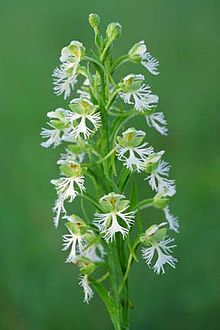- Platanthera leucophaea
-
Eastern Prairie Fringed Orchid 
Conservation status Scientific classification Kingdom: Plantae (unranked): Angiosperms (unranked): Monocots Order: Asparagales Family: Orchidaceae Subfamily: Orchidoideae Genus: Platanthera Species: P. leucophaea Binomial name Platanthera leucophaea
(Nutt.) Lindl.Synonyms - Orchis leucophaea Nutt. (basionym)
- Habenaria leucophaea (Nutt.) A.Gray
- Blephariglottis leucophaea (Nutt.) Rydb.
- Fimbriella leucophaea (Nutt.) Butzin
Platanthera leucophaea, commonly known as the Eastern Prairie Fringed Orchid, is a rare species of orchid native to North America. While it is listed as a threatened species in the United States on September 28, 1989, the IUCN does not recognise it as being at risk.
P. leucophaea arises from a fleshy tuber. The plant can grow up to three feet (91 cm) tall. The inflorescence is large and showy and may have up to 40 white flowers. The leaves are long and thin. It is distinguished from Platanthera praeclara, the western prairie fringed orchid, by its smaller flowers (less than one inch (2.5 cm) long), more oval petals, and a shorter nectar spur. The eastern prairie fringed orchid is a long-lived perennial plant. Its tuber rootstalk helps it survive grass fires. Fires and rain stimulate the plant to grow and flower. The plant emerges each year in May and flowering begins by late June. The flowers are pollinated at night by large sphinx moths. Certain night flying insects that are attracted to the orchid's fragrant are able to obtain its nectar with their long proboscis. Others cannot because of the flower's long, narrow, odd positioned nectar spur.
P. leucophaea is found in moist to wet tallgrass prairie, sedge meadows, fens, and old fields. For optimum growth, little or no woody encroachment should be near the habitat. Historically, the eastern prairie fringed orchid occurred east of the Mississippi River and in Iowa and Missouri. Scattered populations are found in Illinois, Indiana, Iowa, Maine, Michigan, New York, Ohio, Virginia, Wisconsin, and Ontario, Canada. A historic record exists for Choctaw County, Oklahoma. The plant has not been observed in Oklahoma in the past 150 years. The major factor in the decline of the eastern prairie fringed orchid has been a loss of habitat due to grazing, fire suppression, and agricultural conversion.
References
- U.S. Fish and Wildlife Service. Eastern Prairie Fringed Orchid (Platanthera leucophaea)
- Recovery plan for Eastern Prairie Fringed Orchid
External links
Categories:- Orchid species
- Platanthera
- Flora of Ontario
- Flora of Indiana
- Flora of Maine
- Flora of Michigan
- Flora of New Jersey
- Flora of New York
- Flora of Ohio
- Flora of Pennsylvania
- Flora of Illinois
- Flora of Iowa
- Flora of Missouri
- Flora of Nebraska
- Flora of Oklahoma
- Flora of Wisconsin
- Flora of Virginia
Wikimedia Foundation. 2010.

